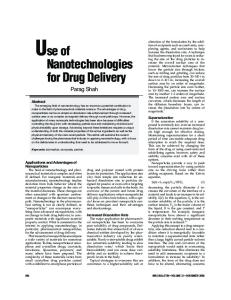Electrochemical Nanotechnologies
Nanoprocessing by means of electrochemical techniques is finding increasing application in various areas such as microelectronics, sensors, materials science, and corrosion; it has also generated new fields of research to promote interaction between biolo
- PDF / 10,496,470 Bytes
- 282 Pages / 439.37 x 666.14 pts Page_size
- 71 Downloads / 318 Views
For other titles published in this series, go to www.springer.com/series/6331
Tetsuya Osaka Madhav Datta Yosi Shacham-Diamand L
Editors
Electrochemical Nanotechnologies
Editors Tetsuya Osaka Faculty of Science and Engineering Waseda University Okubo Shinjuku-ku, Tokyo Japan [email protected]
Madhav Datta Cooligy Precision Cooling Emerson Network Power 800 Maude Avenue Mountain View, CA USA [email protected]
Yosi Shacham-Diamand Faculty of Engineering Tel Aviv University Israel [email protected]
ISBN 978-1-4419-1423-1 e-ISBN 978-1-4419-1424-8 DOI 10.1007/978-1-4419-1424-8 Springer New York Dordrecht Heidelberg London Library of Congress Control Number: 2009942264 © Springer Science+Business Media, LLC 2010 All rights reserved. This work may not be translated or copied in whole or in part without the written permission of the publisher (Springer Science+Business Media, LLC, 233 Spring Street, New York, NY 10013, USA), except for brief excerpts in connection with reviews or scholarly analysis. Use in connection with any form of information storage and retrieval, electronic adaptation, computer software, or by similar or dissimilar methodology now known or hereafter developed is forbidden. The use in this publication of trade names, trademarks, service marks, and similar terms, even if they are not identified as such, is not to be taken as an expression of opinion as to whether or not they are subject to proprietary rights. Printed on acid-free paper Springer is part of Springer Science+Business Media (www.springer.com)
Foreword to Electrochemical Nanotechnology
The advent of nanotechnology has prompted an unprecedented revolution in many fields of science and technology. Outstanding progress in medicine, biology, and energy, just to cite a few, became feasible only by passing from bulk to nano dimensions. Thus, we can safely state that nanotechnology has led to the achievement of a fundamental step forwards in the understanding of life, in the benefit of human kind and in the renewal of our energy scenario. Books that critically review these advances are obviously of valuable importance to the scientific community. This particularly holds for the present monograph, which is focused on a special and key branch of nanotechnology, namely electrochemical nanotechnology. Indeed, electrochemistry has particularly benefited from nanotechnology. Reduction to the nano size has allowed researchers to achieve results otherwise impossible to imagine. By reducing the size of materials, e.g., battery materials, to the nanodimension, jumps in power density and in cycle life have been obtained, finally upgrading devices which were limited to modest uses to highly sophisticated applications. Nanotechnology has also helped to reach unheard of goals in energy conversion by improving the efficiency of solar cells, in medicine by allowing the development of drug dispensers, and in electronics, by opening the route to nanofabrication techniques. Thus, there is no doubt that this book is timely and necessary; and o
Data Loading...











